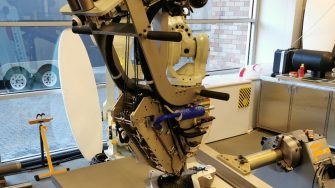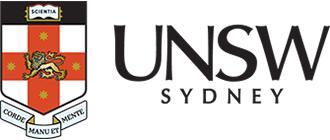
Overview
The development of the shape-adaptive carbon composite propeller blade represents a significant advancement in marine propulsion technology, particularly tailored for large underwater vehicles. Conventional marine propellers, predominantly constructed from nickel-aluminium bronze (NAB), pose various operational limitations, including susceptibility to corrosion, inflexible geometric design, dynamic instability, and intensive maintenance demands. Additionally, their heavy mass necessitates increased energy consumption, leading to inefficient operational performance and elevated manufacturing costs due to labour-intensive production methods. To address these challenges, researchers at the ARC Training Centre for Automated Manufacture of Advanced Composites (AMAC), in collaboration with the Defence Science and Technology Group (DSTG), have developed an innovative composite propeller utilising advanced fibre-reinforced polymer (FRP) materials manufactured through automated fibre placement (AFP) technology. This composite propeller technology achieves considerable advantages such as substantial weight reduction of up to 75%, improved energy efficiency, enhanced corrosion resistance, and superior dynamic stability. Furthermore, the adoption of AFP technology significantly reduces manual intervention, ensuring high production quality, consistency, and scalability for mass production.
The composite blades integrate sophisticated design optimisation algorithms, allowing for bend-twist coupling tailored specifically for enhanced shape adaptability under operational loads. Another innovative feature is the embedment of structural health monitoring sensors within the blade, enabling real-time condition monitoring and significantly reducing long-term maintenance costs. With over 15 years of foundational research and development, backed by DSTG and AMAC collaboration, the project is poised for industrial translation, including advanced manufacturing trials, full-scale prototyping, and integration with additive-manufactured metal hubs. This revolutionary design not only improves operational efficiency but also offers reduced acoustic and magnetic signatures, critical for stealth applications in defence scenarios. Thus, this technological leap marks a transformative step in marine propulsion, promising tailored performance capabilities, reduced lifecycle costs, and expanded applicability in defence and autonomous underwater vehicle (AUV) platforms.
-
Automated fibre placement (AFP) is an efficient and reliable manufacturing method for advanced composites. Further improvement in quality, accuracy and production rates can be achieved by the precise control of manufacturing process parameters. However, improper processing conditions can induce random defects within the laminate, which may compromise the structural integrity. The investigation includes the following:
- Understanding the influence of AFP process parameters on the physical and mechanical characteristics thermoplastic composites.
- Optimization of AFP process parameters for advanced manufacturing of composites.
-
Marine propellers may encounter several types of impact loadings including collision with floating debris. Experimental and simulation-based underwater impact investigation on marine composites is limited. Resistance to impact damage and residual structural properties are crucial to avoid potential loss of structural integrity and performance. The current project investigates the following:
- Underwater impact performance of thin/thick marine composites.
- Finite element based impact performance of composites involving fluid-structure interaction and material property manipulation.
- Multi-scale modeling of impact damage development on thick composites with geometrical features of a marine propeller.
-
omposite propellers undergo ageing while being submerged in the marine environment. Exposure to varying temperatures and water absorption may affect its mechanical and physical characteristics. The current project thus investigates the following:
- Use of embedded sensors to detect moisture absorption and its effect on physical and mechanical characteristics due to seawater ageing.
- Role of crystallinity on the variation of characteristics in thermoplastic composites due to seawater ageing.
-
Current trend in manufacturing is towards digitalization of technologies and processes. Focus has shifted from the performance of single machines and processes towards integration across the entire development chain. 3D printing (Automated Fibre Placement process), extensive digital monitoring framework (embedded sensors), digital twins (virtual simulation) and advanced algorithms (Machine Learning tools such as Artificial Neural Network) are part of major technology pillars towards emerging ‘Industry 4.0’. The project aims at integrating these technologies together for advanced manufacturing of marine composite propellers with enhanced performance.
- Development of predictive models for performance assessment (including impact behavior) of marine composite propellers.
Publications
-
- Shafaq S; Donough MJ; Farnsworth AL; Phillips AW; Chirima G; St John NA; Ben Arber B; Murphy K; Prusty G, 2025, 'On the ply-wise investigation of the crystalline morphology distribution of in-situ consolidated CF/PEEK composite using Wide-Angle X-ray scattering (WAXS)', Composites Part A: Applied Science and Manufacturing, 192, http://dx.doi.org/10.1016/j.compositesa.2025.108792
- Shafaq S; Donough MJ; Bhandari B; Phillips AW; St John NA; Prusty BG, 2025, 'Experimental study on the influence of optimised automated fibre placement processing parameters on the impact response and residual flexural strength of AS4/APC-2 laminates', Composites Science and Technology, 259, http://dx.doi.org/10.1016/j.compscitech.2024.110945
- Shafaq S; Donough MJ; Oromiehie E; Islam F; Phillips AW; St John NA; Prusty BG, 2024, 'Parametric process optimisation of automated fibre placement (AFP) based AS4/APC-2 composites for mode I and mode II fracture toughness', Journal of Composite Materials, 58, pp. 2879 - 2895, http://dx.doi.org/10.1177/00219983241283598
- Rowan L. Caldwell, Peter Davies, Mael Arhant, B. Gangadhara Prusty, Compression and hydrothermal ageing after impact of carbon fibre reinforced epoxy laminates, Composites Part A: Applied Science and Manufacturing, Volume 184, 2024, 108258, ISSN 1359-835X, https://doi.org/10.1016/j.compositesa.2024.108258.
- Shafaq, Donough, M. J., Farnsworth, A. L., Phillips, A. W., St John, N. A., & Gangadhara Prusty, B. (2023). Influence of deposition rates on the mode I fracture toughness of in-situ consolidated thermoplastic composites. Composites Part B: Engineering, 251. doi:10.1016/j.compositesb.2022.110474
- Caldwell RL; Donough MJ; Phillips AW; St John NA; Prusty BG, 2023, 'Dynamic response of composite materials subjected to low velocity impacts in water: A numerical study', Composites Communications, 44, http://dx.doi.org/10.1016/j.coco.2023.101775
- Caldwell, RL, A New Method of Underwater Composite Impact Testing. Proceedings of the International Conference of Composite Materials (ICCM 2023), Belfast, Ireland, 30-July-2023 to 04-Aug-2023
- Maung, P. T., Prusty, B. G., Donough, M. J., Oromiehie, E., Phillips, A. W., & St John, N. A. (2023). Automated manufacture of optimised shape-adaptive composite hydrofoils with curvilinear fibre paths for improved bend-twist performance. Marine Structures, 87. doi:10.1016/j.marstruc.2022.103327
- Shafaq, Matthew J. Donough, Ashleigh L. Farnsworth, Chirima G., Andrew W. Phillips, Nigel A. St John, B. Gangadhara Prusty. Oral Presentation (28th Nov 2023) titled ‘Through thickness crystalline morphology distribution of in-situ consolidated CF/PEEK composites’ ANSTO User Meeting - AUM2023, 26-29 Nov 2023, Hurstville, NSW. Australia
- Islam, F., Caldwell, R., Phillips, A. W., John, N. A. S., & Prusty, B. G. (2022). A review of relevant impact behaviour for improved durability of marine composite propellers. Composites Part C: Open Access, 8. doi:10.1016/j.jcomc.2022.100251
- Islam, F., Wanigasekara, C., Rajan, G., Swain, A., & Prusty, B. G. (2022). An approach for process optimisation of the Automated Fibre Placement (AFP) based thermoplastic composites manufacturing using Machine Learning, photonic sensing and thermo-mechanics modelling. Manufacturing Letters, 32, 10-14. doi:10.1016/j.mfglet.2022.01.002
- Maung, P. T., Prusty, B. G., Oromiehie, E., Phillips, A. W., & St John, N. A. (2022). Design and manufacture of a shape-adaptive full-scale composite hydrofoil using automated fibre placement. International Journal of Advanced Manufacturing Technology, 123(11-12), 4093-4108. doi:10.1007/s00170-022-10527-2
- Shamsuddoha, M., Prusty, G. B., Maung, P. T., Phillips, A. W., & St John, N. A. (2022). Smart monitoring of a full-scale composite hydrofoil manufactured using automated fibre placement under high cycle fatigue. Smart Materials and Structures, 31(1). doi:10.1088/1361-665X/ac3b21
- Shafaq, Matthew J. Donough, Ashleigh L. Farnsworth, Gleny Chirima, Andrew W. Phillips, Nigel A. St John, B. Gangadhara Prusty ‘ Oral Presentation (12th Dec 2022) titled ‘Investigation of Crystallinity Distribution of In-situ Consolidated CF/PEEK Composites with Wide Angle X-ray Scattering (WAXS)’ PPC17, THE 17TH PACIFIC POLYMER CONFERENCE, 11 - 14 December 2022, Brisbane, Australia.
- Maung, P. T., Filippou, P., Shamsuddoha, M., & Prusty, G. (2022). FIBRE STEERING EFFECT ON BEND-TWIST RESPONSE OF A FLEXIBLE COMPOSITE PROPELLER. Paper presented at the ECCM 2022 - Proceedings of the 20th European Conference on Composite Materials: Composites Meet Sustainability.
- Maung Phyo Thu, Filippou Phil, Shamsuddoha Md, Prusty Gangadhara. Fibre steering effect on bend‐twist response of a flexible composite propeller, Proceedings of the 20th European Conference on Composite Materials (ECCM20), Lausanne, Switzerland, June 26-30, 2022
- Herath, M. T., Phillips, A. W., St John, N., Brandner, P., Pearce, B., & Prusty, G. (2021). Hydrodynamic response of a passive shape-adaptive composite hydrofoil. Marine Structures, 80. doi:10.1016/j.marstruc.2021.103084
- Maung, P. T., Prusty, B. G., Phillips, A. W., & St John, N. A. (2021). Curved fibre path optimisation for improved shape adaptive composite propeller blade design. Composite Structures, 255. doi:10.1016/j.compstruct.2020.112961
- Maung, P. T., Prusty, B. G., Shamsuddoha, M., Phillips, A. W., & St John, N. A. (2021). Static and dynamic response of a carbon composite full-scale hydrofoil manufactured using automated fibre placement. Composites Part C: Open Access, 6. doi:10.1016/j.jcomc.2021.100218
- Maung, P., Prusty, B. G., White, J. M., David, M., Phillips, A. W., & St John, N. A. (2019). Structural performance of a shape-adaptive composite hydrofoil using automated fibre placement. Engineering Structures, 183, 351-365. doi:10.1016/j.engstruct.2019.01.014
- Automated Manufacture of Adaptive Composite Hydrofoil” in 4th International Symposium on Automated Manufacturing of Composites, Montreal, Canada, 2019
- Optimisation and Development of Composite Marine Propellers and Hydrofoils” in 7th International Congress on Computational Mechanics and Simulation. (ICCMS 2019), IIT Mandi, India
- Herath, M. T., Prusty, B. G., Phillips, A. W., & St. John, N. (2017). Structural strength and laminate optimization of self-twisting composite hydrofoils using a Genetic Algorithm. Composite Structures, 176, 359-378. doi:10.1016/j.compstruct.2017.05.012
- Maung, P. T., Prusty, B. G., Rajan, G., Li, E., Phillips, A. W., & St John, N. A. (2017). Distributed strain measurement using fibre optics in a high performance composite hydrofoil. Paper presented at the ICCM International Conferences on Composite Materials.
- White, J. M., Maung, P., David, M., Phillips, A. W., St John, N. A., & Prusty, B. G. (2017). Hydrofoil manufacture with automated fibre placement. Paper presented at the 9th Australasian Congress on Applied Mechanics, ACAM 2017.
- Herath, M. T., Lee, A. K. L., & Prusty, B. G. (2015). Design of shape-adaptive wind turbine blades using Differential Stiffness Bend-Twist coupling. Ocean Engineering, 95, 157-165. doi:10.1016/j.oceaneng.2014.12.010
- Herath, M. T., Natarajan, S., Prusty, B. G., & John, N. S. (2015). Isogeometric analysis and genetic algorithm for shape-adaptive composite marine propellers. Computer Methods in Applied Mechanics and Engineering, 284, 835-860. doi:10.1016/j.cma.2014.10.028
- Herath, M. T., Natarajan, S., Prusty, B. G., & St. John, N. (2014). Smoothed finite element and genetic algorithm based optimization for shape adaptive composite marine propellers. Composite Structures, 109(1), 189-197. doi:10.1016/j.compstruct.2013.10.016
- Herath, M. T., Natarajan, S., Prusty, B. G., & John, N. S. (2013). Shape-adaptive composite marine propellers - Analysis and optimization. Paper presented at the ICCM International Conferences on Composite Materials.
- Herath, M. T., & Prusty, B. G. (2012). Performance analysis and optimisation of bend-twist coupled composite hydrofoils using fluid-structure interaction. Paper presented at the Advances in Applied Mechanics Research, Conference Proceedings - 7th Australasian Congress on Applied Mechanics, ACAM 2012.
- Mulcahy, N. L., Prusty, B. G., & Gardiner, C. P. (2011). Flexible composite hydrofoils and propeller blades. Transactions of the Royal Institution of Naval Architects Part B: International Journal of Small Craft Technology, 153(1), B39-B46. doi:10.3940/rina.ijsct.2011.b1.109
- Mulcahy, N. L., Prusty, B. G., & Gardiner, C. P. (2010). Hydroelastic tailoring of flexible composite propellers. Ships and Offshore Structures, 5(4), 359-370. doi:10.1080/17445302.2010.481139
- Mulcahy, N. L., Prusty, B. G., & Gardiner, C. P. (2010). Flexible composite hydrofoils and propeller blades. Paper presented at the International Maritime Conference 2010, Pacific 2010.
- Flexible Composite Hydrofoils and Propeller Blades, PACIFIC2010 International Maritime Conference, Jan 27-29, 2010, Sydney, Australia.
- Mulcahy, N. L., Prusty, G., & Gardiner, C. P. (2008). Optimisation of composite adaptive response with experimental validation. Paper presented at the Civil-Comp Proceedings.
